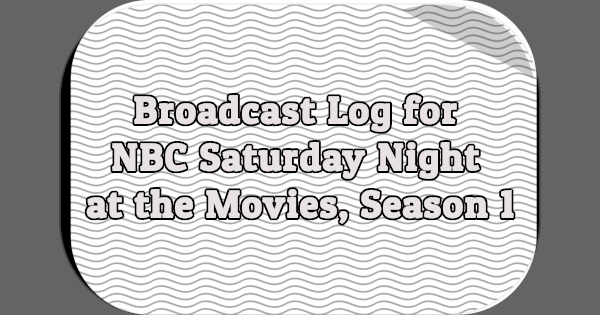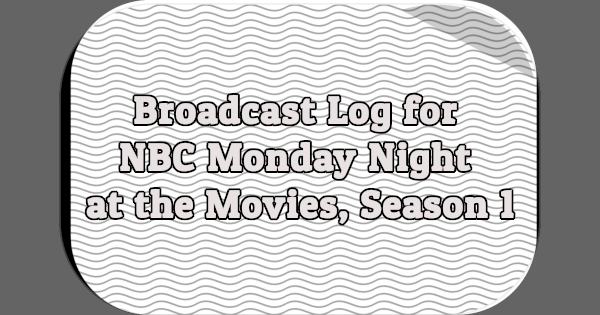NBC Saturday Night at the Movies was the first regularly scheduled network movie night to feature post-1948 movies. Val Adams reported on February 12th, 1961 that the network was approaching Hollywood studios and hoped to purchase 39 films produced since 1948 that had never been televised. The more films in color the better. All would be broadcast uncut. It was “the first prospective deal of its kind between Hollywood studios and a TV network,” one that promised to be lucrative for whichever studio agreed to supply the network [1].
According to Adams, there were two reasons NBC wanted a Saturday movie night. First, the network’s researchers had determined that viewers would welcome one. Second, high profile feature films could potentially counter-program the more successful line-up offered by CBS on Saturdays. On February 16th, Adams revealed that NBC had signed a deal with Twentieth Century-Fox and would be able to chose from some 150 films produced by the studio [2].
NBC Saturday Night at the Movies would air each and every Saturday from 9-11PM. Adams wondered how the network could fulfill its pledge to air the movies in their original “full-length, uncut, feature version” given that some ran two hours without commercials [3]. NBC’s answer? Occasionally, a movie could run past 11PM if necessary. The October 28th broadcast of There’s No Business Like Show Business, for example, ran until 11:15PM.
Here’s what an NBC advertisement in The New York Times had to say about the premiere of NBC Saturday Night at the Movies:
M-M-M-M-M-M-M-M-Marilyn! This, along with a few appropriate and approving whistles, just about sums up our reaction to Miss Monroe. it is very likely these corporate feelings of open admiration were the deciding factor in our selection of “How To Marry a Millionaire” to launch “Saturday Night Movies” — NBC’s fresh new series which will present a star-spangled, post-1950 Hollywood film, uncut and in prime time, every Saturday night during the new season. This is the kind of innovation which is characteristic of the programming service developed over the years by NBC — the network which has opened up the morning hours with the alert, informative “Today,” pioneered late night live television with “The Jack Paar Show,” introduced the conception of the Special program, and developed new forms of presenting news and information programming such as the “Instant News Special” and “NBC White Paper.” In fact, NBC’s entire week-long schedule is designed to serve all significant viewing tastes and interests — with a variety of entertainment, sports, comedy, drama — as well as with television’s greatest number of programs which reach beyond entertainment into enrichment. [4]
A total of 30 films were broadcast during the first season of NBC Saturday Night at the Movies, 22 of which were later rebroadcast during the summer repeat season.
| Season 1: 1961-1962 | |||
|---|---|---|---|
| Ep. # | Title | Airdate | Format |
| 1. | How to Marry a Millionaire | 09/23/1961 | Color |
| 2. | The Snows of Kilimanjaro | 09/30/1961 | Color |
| 3. | Titanic | 10/07/1961 | B&W |
| 4. | The Garden of Evil | 10/14/1961 | Color |
| 5. | The Desert Fox | 10/21/1961 | B&W |
| 6. | There’s No Business Like Show Business | 10/28/1961 | Color |
| 7. | Soldier of Fortune | 11/04/1961 | Color |
| 8. | Halls of Montezuma | 11/11/1961 | Color |
| 9. | Demetrius and the Gladiators | 11/18/1961 | Color |
| 10. | Dreamboat | 11/25/1961 | B&W |
| 11. | Broken Arrow | 12/02/1961 | Color |
| 12. | Man on a Tightrope | 12/09/1961 | B&W |
| 13. | Destination Gobi | 12/16/1961 | Color |
| 14. | O. Henry’s Full House | 12/23/1961 | B&W |
| 15. | On the Riviera | 12/30/1961 | Color |
| 16. | What Price Glory | 01/06/1962 | Color |
| 17. | People Will Talk | 01/13/1962 | B&W |
| 18. | Five Fingers | 01/20/1962 | B&W |
| 19. | Cheaper By the Dozen | 01/27/1962 | Color |
| 20. | The Frogmen | 02/03/1962 | B&W |
| 21. | With a Song in My Heart | 02/10/1962 | Color |
| 22. | Monkey Business | 02/17/1962 | B&W |
| 23. | Stars and Stripes Forever | 02/24/1962 | Color |
| 24. | The Day the Earth Stood Still | 03/03/1962 | B&W |
| 25. | The Black Rose | 03/10/1962 | B&W |
| 26. | Where the Sidewalk Ends | 03/17/1962 | B&W |
| 27. | No Highways in the Sky | 03/24/1962 | B&W |
| 28. | Bird of Paradise | 03/31/1962 | Color |
| 29. | It Happens Every Spring | 04/07/1962 | B&W |
| 30. | Diplomatic Courier | 04/14/1962 | B&W |
| *Summer Repeats Begin* | |||
| REP | Soldier of Fortune | 04/21/1962 | Color |
| REP | How to Marry a Millionaire | 04/28/1962 | Color |
| REP | The Snows of Kilimanjaro | 05/05/1962 | Color |
| REP | Titanic | 05/12/1962 | B&W |
| REP | The Garden of Evil | 05/19/1962 | Color |
| REP | The Desert Fox | 05/26/1962 | B&W |
| REP | Halls of Montezuma | 06/02/1962 | Color |
| REP | Demetrius and the Gladiators | 06/09/1962 | Color |
| REP | Broken Arrow | 06/23/1962 | Color |
| REP | With a Song in My Heart | 06/23/1962 | Color |
| REP | People Will Talk | 06/30/1962 | B&W |
| REP | The Frogmen | 07/07/1962 | B&W |
| REP | Destination Gobi | 07/14/1962 | Color |
| REP | Monkey Business | 07/21/1962 | B&W |
| REP | Stars and Stripes Forever | 07/28/1962 | Color |
| REP | The Day the Earth Stood Still | 08/04/1962 | B&W |
| REP | The Black Rose | 08/11/1962 | B&W |
| REP | Where the Sidewalk Ends | 08/18/1962 | B&W |
| REP | No Highways in the Sky | 08/25/1962 | B&W |
| REP | Bird of Paradise | 09/01/1962 | Color |
| REP | It Happens Every Spring | 09/08/1962 | B&W |
| REP | Diplomatic Courier | 09/15/1962 | B&W |
NBC Saturday Night at the Movie remained on the air until September 1978. It has reappeared sporadically ever since.
Works Cited:








I’m curious does anybody know what was the first movie to be edited for broadcast if these first 30 movies aired “uncut”?
Executive Suite. Why, I don’t know. :)
The THIRD (and most important) reason NBC wanted “SATURDAY NIGHT AT THE MOVIES” is because their Saturday night schedule [especially after 9pm(et)] was losing ground to CBS {“HAVE GUN-WILL TRAVEL”, “GUNSMOKE”} and ABC {“THE LAWRENCE WELK SHOW”}. Leasing a “block” of “recent” movies from one (or more) studios was actually cheaper than buying two or three weekly “scripted” programs to fill a two-hour time period- and depending on the movie, could “bump” the network’s ratings on any given Saturday. However, there were “limitations”: 20th Century-Fox’s “CinemaScope” movies could not be seen in a “widescreen” format [there wasn’t even talk about “letterboxing” the picture back then], so there were plenty of “pan and scan” repositioning in those pictures where, say, Marilyn Monroe would appear to be talking to herself rather than Lauren Bacall and/or Betty Grable {they’re over THERE, out of “standard frame” range}. And, if a movie’s original running time was over 100-110 minutes, SOMETHING would have to be “sliced out” to make room for titles, transitions, station breaks, and 12 minutes of commercials. And for color TV enthusiasts, only half of the scheduled films were in color.
Viewers didn’t mind. The lure of seeing a feature film they hadn’t seen at the local movie theater (or wanted to see again) was irresistible, and NBC got very good ratings for its first season {IF, however, the experiment had failed, the network had a “bug out” clause in their contract with Fox to cancel their agreement, and “SATURDAY NIGHT AT THE MOVIES”, after 16 weeks}. So much, in fact, that ABC tried to patch the “leaky hole” [8-10pm] in their Sunday night schedule in April 1962 (after their “dependable” lineup of Westerns and action/adventure series, including the notorious “BUS STOP”, had faltered} with their own “package” of recent movies, “HOLLYWOOD SPECIAL” [which became “THE SUNDAY NIGHT MOVIE” in 1964].
To answer your question, ‘pBob’, it had to have been “Irving Berlin’s There’s No Business Like Show Business” (1954), which had a theatrical running time of 117 minutes. For its October 28th “world television premiere”, SOMETHING had to be cut to make it fit a two-hour time slot with commercials {a “minor” musical number or two, perhaps? Some of Johnnie Ray dialogue?}.
I just checked and it turns out that the October 28th broadcast ran until 11:15PM, meaning it likely was not edited for time. And I doubt any of these films had to be edited for content.
I wasn’t old enough to stay up to see it, ‘RGJ’, so I wasn’t aware NBC extended the length of that evening’s movie to 2 AND 1/4 hours. In those days, apparently the network DIDN’T edit any of those films for “time constraints” [as is done these days], so “extended” editions, like sporting events, were not uncommon. As for “content”…certainly not! There was no swearing, bad language or any “indecency” in those 1949-’55 features {they were all filmed under the Hollywood “Production Code”, which was somewhat relaxed by the late ’50s}.
…And what makes you feel *really* old is remembering when you and/or your parents made plans to catch a particular movie on TV rather than go out on that night.
O, for the days when TV was still new and unique territory to explore…
I was a young kid when NBC aired this great show. I particularly recall the anouncers voice & what an impression that had on me. NBC truly set the standard for movies on TV & they did it with such style.
NBC’s launch of “Saturday Night at the Movies” had an effect of the direction of the late weekend evening editions of its New York flagship WNBC-TV’s “Movie 4” franchise (kind of a poor man’s version of WCBS-TV’s “The Late Show” in those days, before its weekday afternoon editions, in its final years on the air [up to 1974], became an even poorer man’s equivalent of WABC-TV’s “The 4:30 Movie”). As a result of “SNATM’s” debut, WNBC shifted “New York television premiere” nights for “Movie 4” from Sunday to Saturday nights, and acquired 41 post-1950 Warner Bros. titles that at the time were syndicated by Seven Arts Associated (which went on to acquire Warners’ in 1967). The very night “SNATM” showed “How to Marry a Millionaire” on Sept. 23, 1961, WNBC’s “Movie 4” presented the New York TV debut of the 1955 James Dean flick “East of Eden” which was one of a handful of notable times their movie showcase beat WCBS’s late-night institution in the ratings. (Other such titles premiered by WNBC during that season after the late news that followed “SNATM” included Paul Newman’s infamous film debut “The Silver Chalice,” “Storm Warning,” “Trouble Along the Way,” “Captain Horatio Hornblower,” and “Young at Heart.”)
And I presume that WNBC, like the network, would be able to broadcast color movies in color on their late-Saturday-night “Movie 4” in the early-to-mid sixties.
On weekends, yes. WNBC didn’t run color films in color on their weekday “Movie 4” until 1965.
The announcers for “Saturday Night at the Movies,” from the outset, would have been from within the network’s Burbank studios, and also worked at what was then called KRCA (Channel 4) in Los Angeles (the calls changed to KNBC on Nov. 11 or 12, 1962) – as it would be the case as evidenced in the late 1960’s and into the ’80’s. The West Coast announcing staff at the time of “SNATM’s” debut and throughout its early years would have consisted of such voices as Don Stanley, Donald Rickles (no relation whatsoever to the “hockey puck” comic), Arch Presby, Frank Barton, Eddie King, Vincent Pelletier, John Storm, and possibly Hal Gibney. King was heard on the network’s movie shows well into 1975; Presby retired in 1972, Barton in 1974, Storm left NBC in 1969, and Gibney died in 1973. Rickles remained one of the announcers up to his death in 1985. By the mid-1970’s the core announcers on NBC’s movie shows had become Stanley, Rickles, Peggy Taylor and Victor Bozeman.
NBC should have postponed the showing of the 1953 “Titanic” to April 14th, 1962, since that was the 50th anniversary (to the day!) of the disaster.
Imagine the publicity (and ratings) the network could have gotten for airing the movie on the 50th anniversary of the event it dramatized!
It’s funny to see a “rerun” season of movies which weren’t originally made for tv anyway. I wonder how the 8 movies that weren’t “rerun” were selected; maybe by original ratings or cost or (in the case of “There’s No Business like Show Business”) the overrun time. I agree with the person who suggested that Titanic should’ve been run (or maybe even “rerun”) on Apr. 14, 1962, but I don’t imagine there was as much looking back at the past then, with as many types of media to fill currently, as there is now.
Maybe not with these early broadcasts, but eventually they began slightly speeding films up, thus making a better fit for the time slot.
Beginning with the opener of the first season, How to Marry a Millionaire, many of the films in this series had been filmed in CinemaScope, at its original 2.55:1 raltio, and so had to be “formatted to fit your screen” i.e. shown pan/scan in the conventional 4:3 TV ratio, losing nearly half of the image in the process, and literally destroying the composition of each scene.
The rest of the CinemaScope titles that followed were: The Garden of Evil, There’s No Business Like Show Business, Soldier of Fortune and Demetrius and the Gladiators.
I remember watching the Beatles in A Hard Day’s Night on Saturday night at the movies I saw the priginal release in a movie theater in Texas in 1964.
One mistake I noted in your 1961-62 list of movies: “The Black Rose” was filmed in Technicolor, so I would assume it was a March 1962 color telecast by NBC, the self-styled “color pioneer” of the 3 networks back then, rather than black-and-white.
I have without luck been searching for SNATM lineups from LATER seasons. I was just old enough (10 yr. old) to secure my parents’ permission to stay up and watch SNATM starting Season 1 and that is how I saw Desert Fox, Halls of Montezuma, and What Price Glory? for the first time. Season 2 I saw even more SNATM movies and Season 3 even more. As of the mid-to-late-1960s I was watching about 80% of the movies shown on SNATM…and the series programmed, and I loved, what I later learned were considered absolute classics (such as Battleground, Vertigo, Rear Window, A Place in the Sun, and more). It was SNATM that turned me into a life-long movie buff. I watched all those films in my bedroom on my little Zenith 21-in. BLACK-AND-WHITE television set, with “rabbit ears” and a bulky remote control. Wonderful memories!